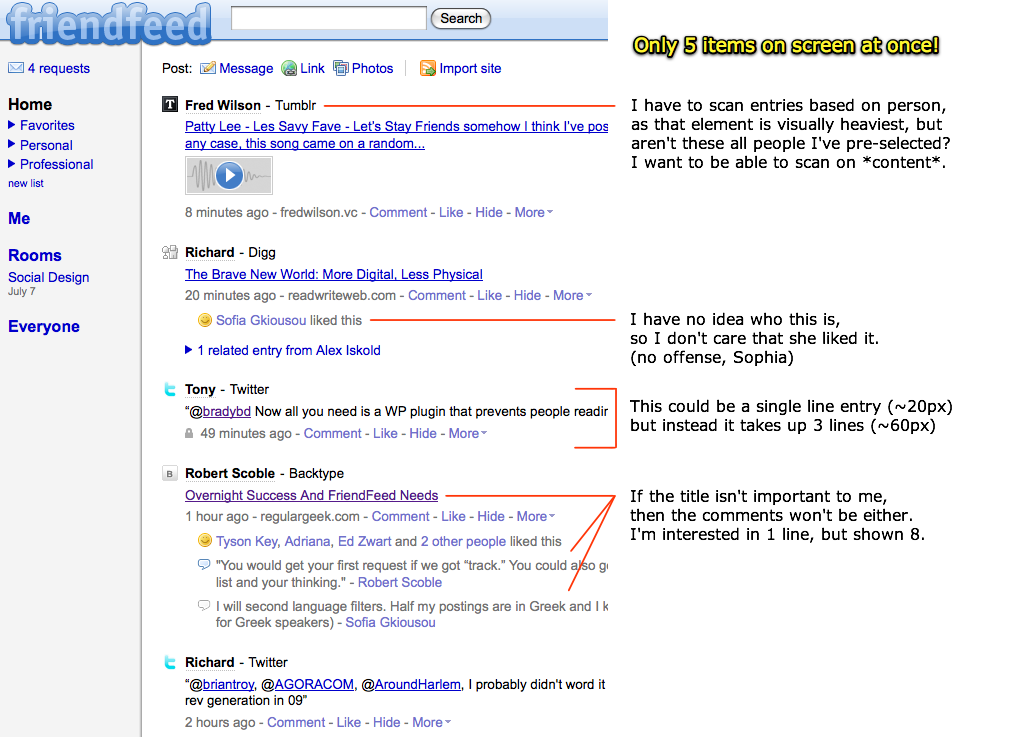Thoughts on the Friendfeed interface
Note: Before I wrote this Paul Buchheit (of Friendfeed) had responded to others’ posts with a great post of his own Overnight success takes a long time and asked for feedback on the Friendfeed service. Consider this my contribution… Some modest suggestions for improving the Friendfeed interface Friendfeed is getting a lot of chatter in […]
Note: Before I wrote this Paul Buchheit (of Friendfeed) had responded to others’ posts with a great post of his own Overnight success takes a long time and asked for feedback on the Friendfeed service. Consider this my contribution…
Some modest suggestions for improving the Friendfeed interface
Friendfeed is getting a lot of chatter in the blogosphere about what they should do with their service. I’m sure I don’t know the bigger issues that Friendfeed are dealing with, but I do have some observations about the interface, which I’ve summarized below.
But first, a little rationale about how I got to these suggestions. We must start with the simple question: What is the core mechanic of Friendfeed? What is the one thing that Friendfeed does that makes it a valuable service? I would argue that it’s reading the feeds of friends in order to discover valuable content.
The first thing you’ll notice when you set up an account, however, is that Friendfeed is a fire-hose of content. Like other streams, it produces way too much content to keep track of comprehensively. To that end, one of Friendfeed’s primary goals has to be the efficient management of the fire-hose. The service can do this in two ways: by providing powerful search and filtering features to reduce/organize the content one sees or by making the interaction with each piece of content more efficient.
Friendfeed seems to have a good handle on the first way, providing powerful search features and filters in the form of lists, rooms, ways to hide content, etc. I’m sure there are other good ways to push forward here, like a better notion of “quality” or recommendations or something similar. But the features Friendfeed has now are pretty good at letting people filter and organize content.
I think Friendfeed could focus more on the 2nd way of dealing with the fire-hose: make the interaction with each piece of content more efficient. The core problem with the Friendfeed interface, to that end, is that it is not easily scannable. By making the interface more easily scannable, the value of the entire application would increase.
Here’s a screenshot I’ve annotated illustrating how Friendfeed might make their interface more scannable:
(click for full-size)
Too few items per screen
There are, on average, 4 to 5 items displayed per screen. This means that you can only see 5 items before you have to scroll down the page. It could be a lot more, like up near 15, if not 20 or more. Gmail, for example, which uses a mere 20 pixels of vertical screen height per item, can fit 25 items in the same amount of space. This allows for much faster scanning. (obviously the Friendfeed guys know this, as Paul designed Gmail, so I’m really curious about their design decision here)
Secondary information clogs up each item
The reason that there are too few items per screen is that Friendfeed uses a tremendous amount of vertical space to show items of secondary importance, including Likes, Comments, and the time the entry was posted. These items should be available, of course, but they needn’t take up so much room.
Now, it’s probable that Friendfeed keeps these comments inline because they are trying to bring conversation to the forefront. This makes sense. As you show more conversation, you get more conversation. But there are also ways to show there is a conversation without showing the actual comments…like for example displaying “5 comments” near an entry and allowing people to view the comments if they so choose.
Difficult to scan content titles quickly
As you can see from the screenshot, the element with the most visual weight in the Friendfeed interface are the names of people where the content originates. But is this the most important part of that content? I think that the title of the content is the most important part, and thus that should have the most visual weight, and thus be the most scannable. The person who submitted it is important, but secondary in my opinion, especially because these people are already in our good graces (we’ve subscribed to them).
People who aren’t my friends
By default, Friendfeed displays a whole bunch of content from people who are “friends of friends”. This content isn’t from people who you have chosen to receive content from, but from the people your friends have chosen to see content from. This is one of my long-standing frustrations with the interface. I have a hard enough time trying to make sense of the fire-hose of just my friends. Including more people that I don’t ask for is just too much.
So, in a word I think it’s all about scannability. I’m not suggesting that Friendfeed remove any of these features, but in the current design I just see too many distracting bits of information. Since Friendfeed opens up a veritable fire-hose of content, the interface needs to make the interaction with each bit of content as efficient as possible.
